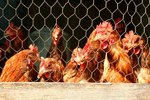Things You'll Need
Brooding area
Straw, hay or peat moss
Heat lamp with infrared bulb
Brooding thermometer
Baby duck feed
Chicken grower ration
Corn grain
Non-slippery paper
Greens
Drinking water
Shallow pan or trough with wire guards
Considered one of the most beautiful of all water birds, according to the Cornell Lab of Ornithology, the wood duck is a member of the family Anatidae, which also includes geese and swans. Wood ducks were near extinction at the turn of the century, but wildlife conservationists and sportsmen supported limitations on hunting wood ducks during the 1930s, which has resulted in a renewed population numbering in the millions, according to the Virginia Cooperative Extension. Ducks are hardy and present few problems in the journey to adulthood, says the University of Minnesota Extension website.
Prepare a Brooding Area
Prepare a draft-free, half-square foot of floor space for one baby wood duck that is 2 weeks old or younger.
Cover the floor with about 4 inches of dry straw, hay or peat moss to serve as bedding.
Add a half-square foot of space to the brooding area when your duck reaches 3 weeks of age. Add an additional half-square foot each week until the area measures 2 square feet.
Remove wet bedding material daily.
Keep Your Duck Warm
Place a heat lamp with an infrared bulb in the corner of the brooding area, at least 12 inches above duckling level.
Measure the temperature in the brooding area with a brooding thermometer. Hang the thermometer from the heat lamp, just above duckling level. An appropriate temperature for a duckling of under 3 weeks of age is 85 to 90 degrees.
Begin lowering the temperature when you notice your baby duck continually distancing itself from the heat source. Lower the temperature 5 degrees each week until you reach 70 degrees.
Feeding Your Duck
Start your duck on feed formulated for baby ducks. If this type of feed is not available in your area, substitute with chick starter.
Begin feeding your duck a chicken grower ration and cracked corn after 3 weeks of age. The duck will not overeat; always have feed at its disposal.
Avoid leg injuries by placing the feed on non-slippery paper for the first week; fine sandpaper works well. Remove wet and soiled feed each day.
Offer greens--such as grass, clover, dandelions, lettuce or cabbage--to your duck daily.
Place fresh drinking water in a shallow pan or trough with wire guards. To prevent drowning, the water should be deep enough for your duck to dip only his bill and head into. Adjust the depth accordingly as your duck grows.
Tips
If your duck makes an unusual amount of noise, it is probably cold; check the temperature in the brooding area.
Warnings
Do not feed bread, onions or birdseed to ducks.
References
Photo Credits
-
duckling image by Aleksander from Fotolia.com
Writer Bio
Kathleen Bona has been enjoying her career as a freelance writer for the past two years. Her areas of expertise include the care of animals, cooking, astrology, entertaining and green living. She also works as a ghostwriter for various websites and blogs.




